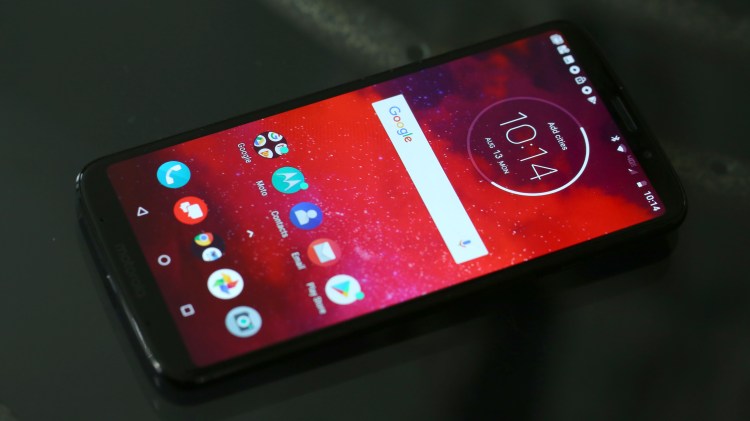As a long-time iPhone user, I’m not likely to just randomly switch to an Android phone. There would have to be a really good reason — and a truly great Android device — to make me pull the trigger.
On paper, Motorola’s new Moto Z3 has one of the most compelling Android phone pitches I’ve yet heard: Pay a reasonable price now for a modern 4G phone, then use a bespoke accessory to add next-generation Verizon 5G support early next year. Leveraging tomorrow’s most transformative technology to sell phones today is an ingenious strategy.
I’ve had the opportunity to test the Moto Z3 since last week, and though it won’t actually make me (or most iPhone users) switch, it could win over a certain group of Android fans. Specifically because of its 5G expandability, it might become a primary phone and portable hotspot for some people, though that won’t be clear until Motorola and Verizon disclose their 5G hardware and service pricing — we asked, and they’re not talking.
Without its 5G attachment, the $480 Moto Z3 is a story of two phones: It’s like an iPhone X on the outside, and an iPhone 7 on the inside. While it initially appears to be a rare example of a virtually future-proof product, the devil — as always — is in the details.
June 5th: The AI Audit in NYC
Join us next week in NYC to engage with top executive leaders, delving into strategies for auditing AI models to ensure fairness, optimal performance, and ethical compliance across diverse organizations. Secure your attendance for this exclusive invite-only event.
On the outside, it’s like a half-priced iPhone X
When I say that the Moto Z3 is superficially like a half-priced iPhone X, I mean that in the nicest possible way: If you’ve never used Apple’s $1,000 flagship, you’ll be hard-pressed to spot meaningful differences between them. Motorola went with a fully glass front and back, joined by a polished black 6000-series aluminum frame, so apart from the Z3’s slightly different curves and notchless top and bottom bezels, they look extremely similar.
Moto Z3’s 6-inch screen is lower in resolution than the iPhone X’s, and LCD rather than OLED, but the average person’s not going to care much about these differences. Instead, they’ll see a very bright, beautifully saturated display that’s entirely usable even at one-third power. They’ll also appreciate that the Moto Z3’s 0.2-inch larger screen supports Android’s split-screen mode that’s missing from the iPhone X (but likely to show up in the larger and more expensive Plus-sized version next month).
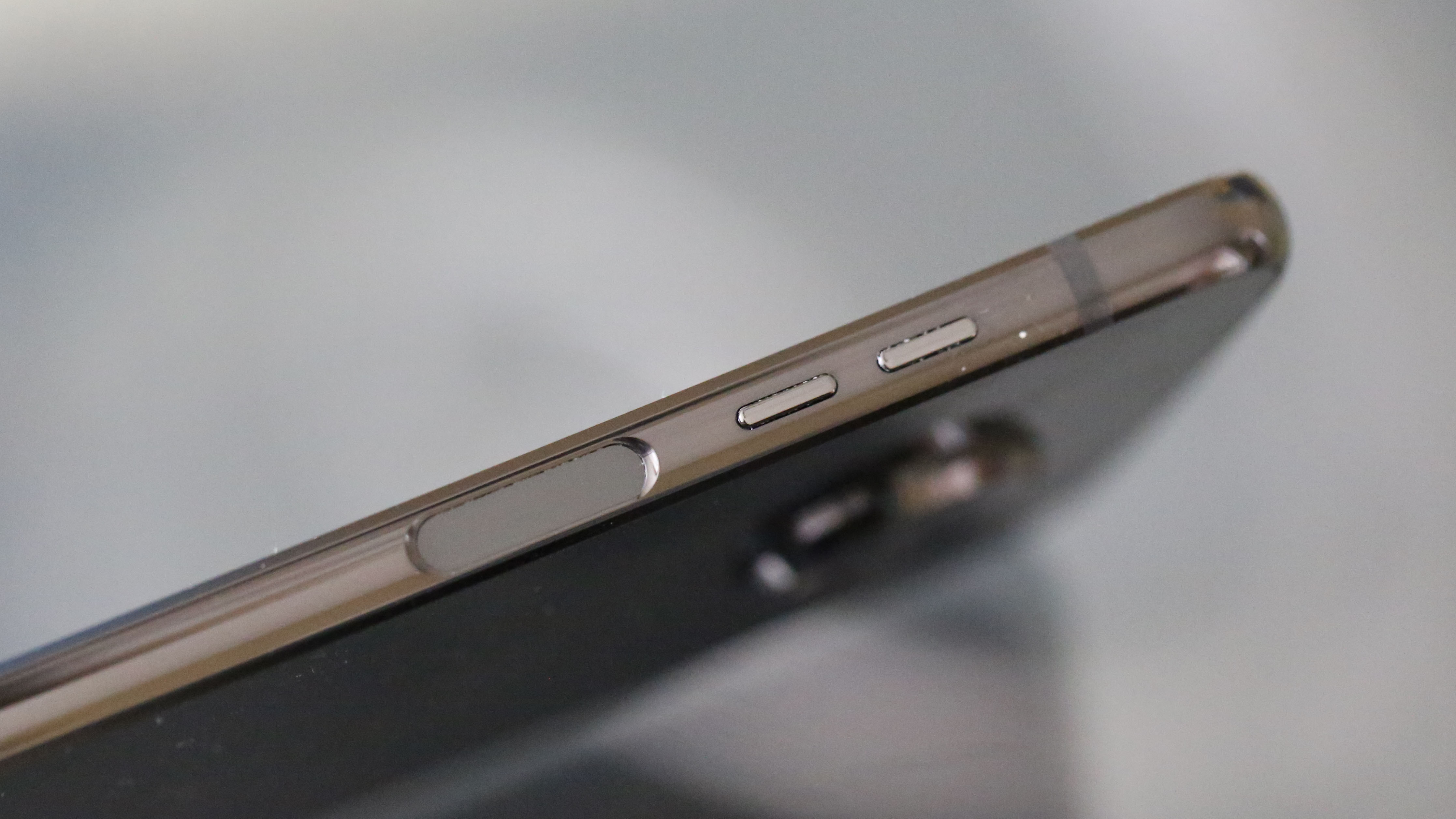
Above: Moto Z3 fingerprint scanner.
One thing I was surprised to love about the Moto Z3’s exterior is its side-mounted fingerprint scanner. Placed right underneath the volume buttons on Z3’s right, it’s in just the place where my finger normally grips the phone, making unlocking fast and effortless… when the feature works. In my experience, that’s most of the time, and in any case more frequently than the iPhone X’s still-spotty Face ID unlocking experience. If the scanner had more surface area — it’s limited by Z3’s 6.75mm thin chassis — it would be perfect.
The finger scanner isn’t Moto Z3’s only option. Its front camera supports Face Unlock, which automatically unlocks the device using photo recognition when you lift up the camera to your face. Unfortunately, the phone openly disclaims Face Unlock’s security, saying that it’s less protective than using a password, PIN, or fingerprint. In practice, I also found that it worked far less often than either Z3’s fingerprint scanner or Apple’s Face ID. But it’s there if you’re willing to accept a “not great” alternative unlocking experience.

Above: Moto Z3’s beautiful but constantly fingerprint-smudged back.
One thing I hate about the Moto Z3’s exterior is how much its body makes me worry about accidental damage. Just like the iPhone X, every one of its glossy surfaces is a magnet for fingerprint smudges, and I found myself worried about future accidental drops. While I quickly came to love the way the Z3 feels in my hand, I can’t get past concerns that it will scuff, chip, or shatter.
On the inside, it’s not quite an iPhone 7
There are so many Android phones — even ones in the Moto Z series — that they’re really hard to meaningfully tell apart at this point. Moreover, almost any recent Android phone around the $500 price point has enough hardware and software horsepower to be a competent phone for typical daily use. Armed with Qualcomm’s aging Snapdragon 835 and Android 8.1 Oreo, the Moto Z3 falls squarely into that “competent” category.

Above: Android 8.1 Oreo on the Moto Z3.
I use my phone primarily for photography and videography, making audio and video calls, navigation, and reading news. Besides those things, I’ll occasionally play a game and use a social media service. So I care about having great cameras, solid wireless (including phone and GPS), and a fairly powerful CPU/GPU combination.

Using Geekbench 4, the Moto Z3 benchmarks at 1924 (single-core) and 6529 (multi-core), which is to say halfway between an iPhone 6 (~1550) and iPhone 6s (~2500) in single-core and closer to the iPhone 7 (~5900) than 8 (~10100) in multi-core. In practical terms, this means the late 2018 Z3 performs roughly like a late 2015 or 2016 flagship device for everyday tasks, which is to say most apps outside of games and photography.
Most of the time, that’s a difference you won’t feel. But there are times when the Z3’s interface shows its chips’ lack of speed and software optimizations. I always noticed the GPS needing a few seconds of extra time to get started when I used Google Maps for navigation, and apps taking just a little longer than “immediately” to open.
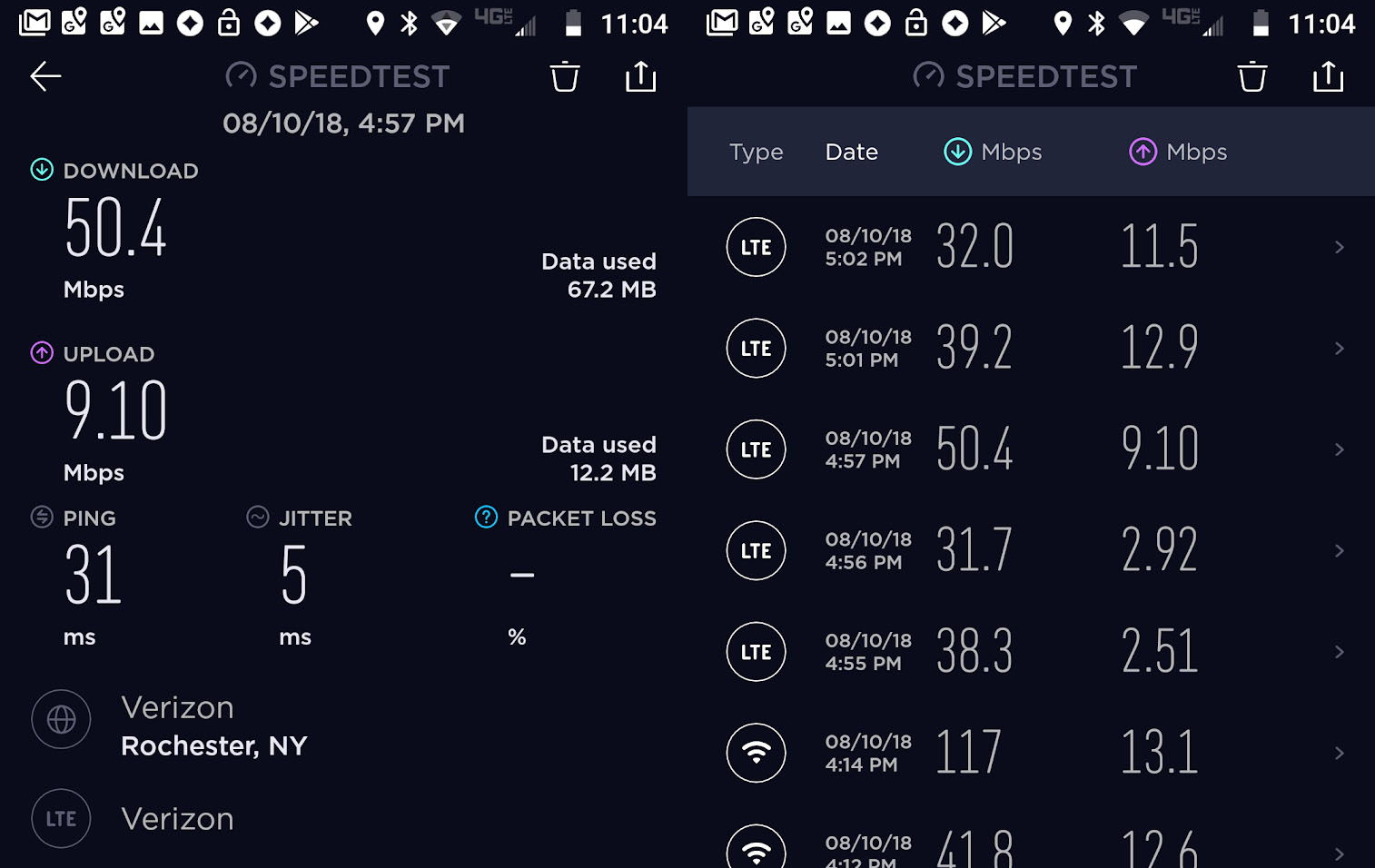
On the wireless side, I never came close to the peak 4G speeds the Z3 is already capable of. At home, I saw roughly 10Mbps downloads and under 2Mbps uploads with Verizon, lower than (but in the same general ballpark) as the mediocre LTE performance I get at home with my iPhone on T-Mobile. But outdoors, I was able to hit 50.4Mbps down and 9.1Mbps up at one point, better on the download side at least than the U.S. national average.
The problem there isn’t the device — it’s the LTE network. On my home Wi-Fi network, the Z3 hit 117Mbps down and 13Mbps up, within 1Mbps of the numbers of my iPhone. When 5G networks are available, a Z3 with the 5G Moto Mod should frequently be able to reach 10 or more times that speed, but for now, it’s limited by the 4G networks we all have.
I wasn’t blown away by Moto Z3’s camera performance. On paper, the specs are fine: twin 12MP rear cameras (one color, one monochrome) with f/2.0 aperture, laser autofocus, and 4K/30p video recording, plus a f/2.0 8MP front camera with 1080p recording. In practice, the Z3 tends to produce overly cool photos and videos that too often were soft due to normal hand motion. It also tended to overexpose and blow out indoor shots, leaving unrecoverable highlights.

Above: The Moto Z3’s rear camera (below) overexposes and blows out highlights compared with the iPhone X’s rear camera (above). It also has a narrower field of view.

The rear camera’s single field of view is a less ideal compromise between the twin fields of view offered by recent iPhones, while its front camera is noticeably wider — an 84 degree FoV — which is better for wide-angle selfies but worse for portraits. Moto Z3 supports software-based background blurring, a Cinemagraph mode that lets you freeze most of an image while animating a portion of it, and a variety of filters. A true black and white mode is also offered for the monochrome rear camera.

Above: Moto Z3’s front camera (left) has the same color coolness as its rear camera, but the advantage of a noticeably wider field of view, enabling more people (or background) to fit into a selfie than a current-generation iPhone.
A brief note on games: You can expect Moto Z3 to do just fine with most of the mobile games currently on the market. As a stress test, I tried the popular 3D battle royale game PUBG, which notably defaulted to “high” settings — a good thing — and ran in the low- to mid-20fps range during a brief playtest session.

Above: PUBG on Moto Z3.
The Moto Z3 isn’t a top-of-line flagship Android phone, but for most intents and purposes, it’s only a couple of steps behind the leading devices today. My big question is whether that’s a solid enough foundation for a “5G upgradeable” phone.
Here’s what this all means for 5G
Fifth-generation (5G) cellular networks will be launching later this year in the United States, with the promise of radically improved network performance: Depending on where you live (and how bad your existing 4G network connection is), you could see 10 to 100 times current speeds when receiving and sending files. During Moto Z3’s announcement, executives suggested that adding the 5G Moto Mod will let Z3 users quickly download a last-minute movie before hopping on a plane and have sufficient cellular bandwidth to share it with other devices.
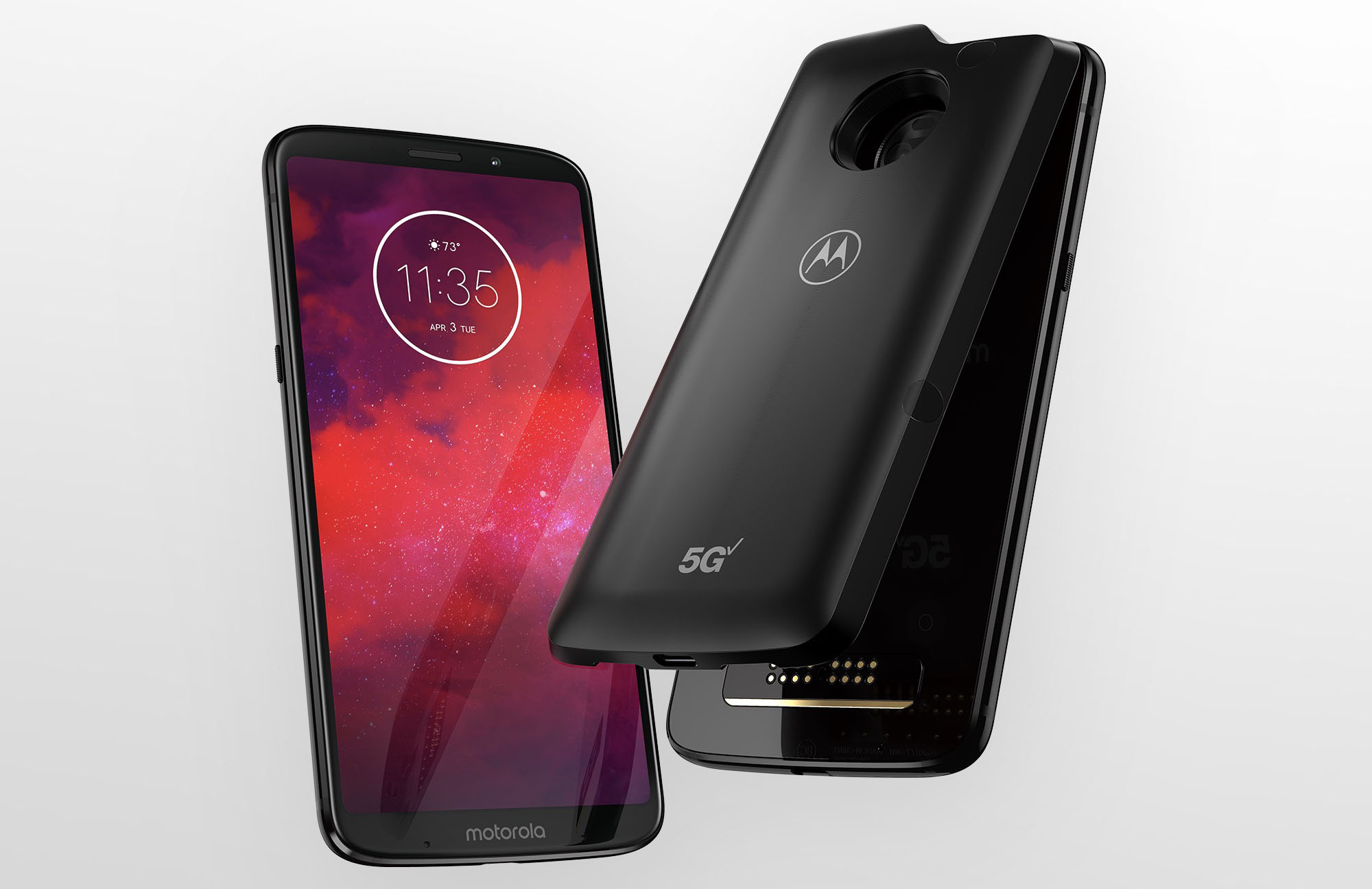
Above: Motorola’s 5G Moto Mod signals the dawn of a new era for telecommunications – 5G.
As smartphone accessories go, the 5G Moto Mod is truly interesting. From the outside, it’s not much different from a Mophie Juice Pack battery, except that it attaches directly and magnetically to a pin panel on the lower bottom of the Moto Z3’s back. Inside, it contains twin modems — a first-generation 5G modem and an ultra-modern 4G modem — which are designed to let it squeeze maximum data rates out of whatever network is nearby.

The brilliant part of Motorola’s and Verizon’s pitch is that every Moto Z3 owner is a potential 5G customer — and one with reasonable incentives to actually sign on. A 5G Moto Mod is likely to be smaller than early standalone 5G hotspot pucks, and in 5G’s earliest days, the promises of more bandwidth and faster video downloads may be enough to win some customers. Some people might even be able to ditch their existing broadband service for 5G… if the price is right.
But pricing remains a cloud over Motorola’s and Verizon’s heads — it’s hard to get excited about or recommend the Moto Z3 to anyone without knowing pricing for both 5G service and the 5G Moto Mod. I reached out to ask how much the hardware and service would cost, but was told that the companies are not disclosing those details now.

As concerning as the hardware and 5G service numbers may be on their own, Moto Z3 has a Mobile Hotspot screen to remind you that Verizon may add another charge for Mobile Hotspot tethering. There’s certainly potential for nickel-and-diming to stifle 5G’s growth.
Another big question is how much late-4G-generation devices like the Moto Z3 will really be able to take advantage of 5G’s capabilities. Putting the increase in bandwidth aside, will you really need to have 5G speeds to watch 1080p videos on the Moto Z3’s screen? Will you really be able to use it for any sort of VR or other ultra-high-bandwidth video streaming applications? How will it actually handle sharing a 5G connection with multiple tethered devices?
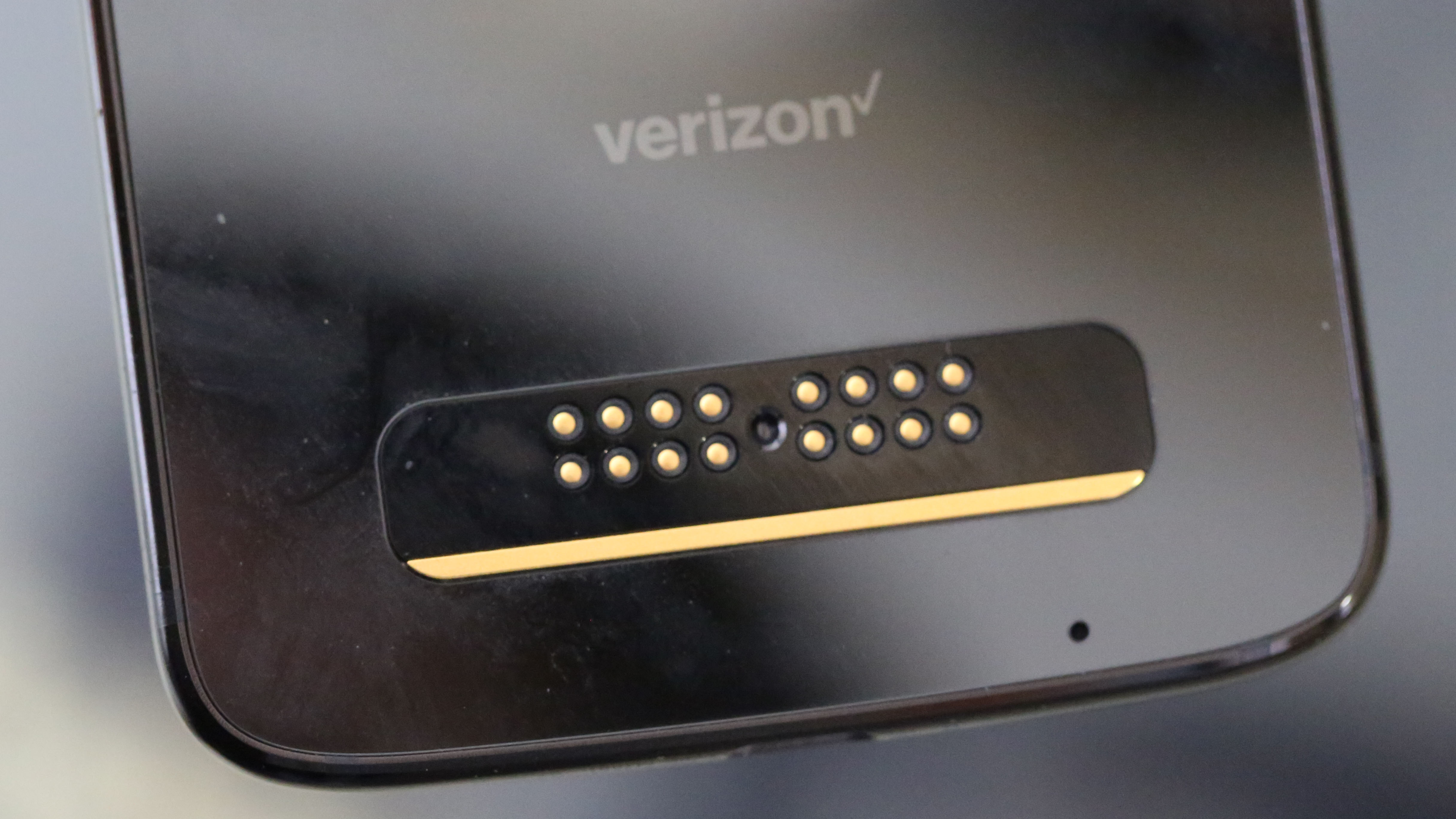
Above: The 5G-ready Moto Mod connection pegs on the back of the Moto Z3.
These sorts of questions are critically important to answer properly before recommending the purchase of a Moto Z3 — and I won’t have the definitive answers until I get to put it through stress tests with a 5G Moto Mod on an actual 5G network. So until then, this is merely a hands-on rather than a full review; I’m excited to see what the Z3 can do when its most important accessory is actually available with hardware and service pricing.
For the time being, I would suggest that only a very specific group of Android users think about owning the Moto Z3: people who aren’t as concerned about owning a flagship phone as a very solid one, yet also don’t want to be left behind next year at the start of the 5G transition. If you want a good phone now that could become a 5G portable hotspot for work, consider the Moto Z3 — but I would strongly suggest waiting on the purchase until both Verizon and Motorola become transparent on their 5G pricing.
